Article Highlights
Quartz, one of the most abundant and diverse minerals on Earth, shows up in a range of forms, and black quartz is no exception. Black quartz isn’t just a pretty face—it’s got an impressive backstory and some seriously cool geological properties.
Origins and Formation
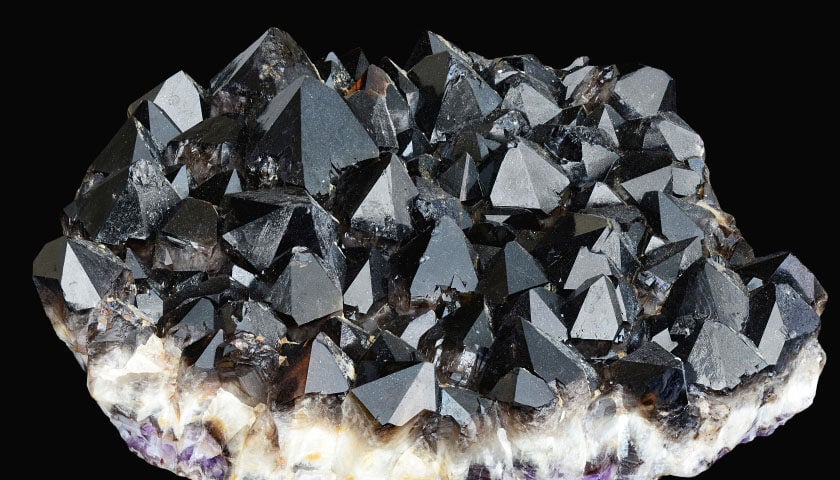
Black quartz originates much like its clear cousin, but it owes its distinctive color to a bit of geological alchemy. Quartz forms when silicate-rich solutions seep into cracks and cavities in rocks. Over time, these solutions crystallize into quartz. When certain impurities are present in these solutions, they can lend color to the quartz crystals.
In the case of black quartz, it’s all about irradiation and mineral inclusions. You see, when clear quartz is naturally irradiated, either by nearby radioactive minerals or cosmic rays over a long period, it can darken, producing smoky quartz. This can range from a light gray to a deep, almost black color.
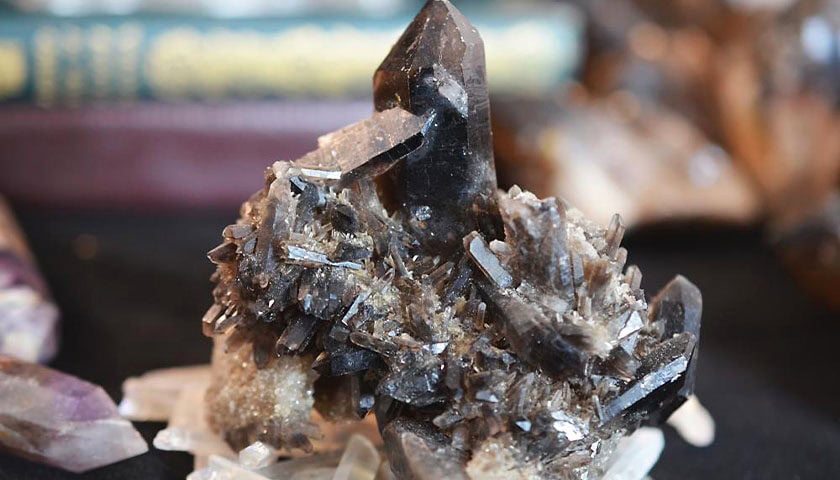
But we don’t stop there. Some quartz crystals become black because of dark mineral inclusions. The most common minerals that cause this are tourmaline and rutile. If you’ve ever seen black tourmalinated quartz or black rutilated quartz, you’ve seen this in action. These minerals form in long, slender crystals, creating unique and beautiful patterns inside the quartz.
Geological Properties

We’ve had a bit of a chat about how black quartz comes to be, but let’s talk about what it’s really made of. At its heart, quartz is a compound of silicon and oxygen, forming silicon dioxide. It’s the second most abundant mineral in the Earth’s continental crust, so you could say it’s quite the popular kid on the geological block.
Quartz is a hard cookie too, with a Mohs hardness of 7. That’s harder than most minerals and makes it pretty resistant to weathering and erosion. This toughness also means it’s a prime candidate for a variety of uses, from gemstones to industrial applications.
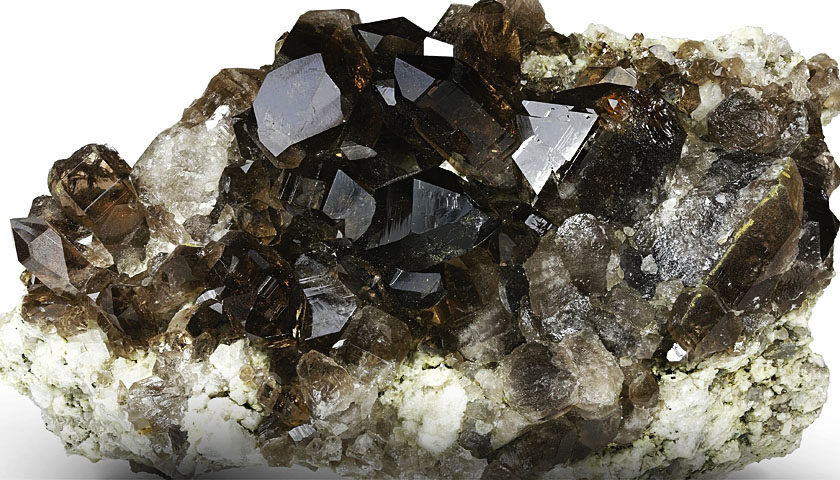
The specific gravity of quartz, including black quartz, typically ranges from 2.65 to 2.66. This is fairly consistent across all varieties because, despite differences in color and inclusions, the overall structure and composition remain the same. That’s some reliable stuff right there.
Now, if you’re into shapes and symmetry, you’ll get a kick out of quartz. Quartz crystals are hexagonal, meaning they have six sides. These crystals can form in a variety of habits, or shapes, from short and stubby to long and prismatic. Black quartz, despite its unique coloring and inclusions, follows these same rules, proving that it’s still a quartz crystal through and through.
Varieties of Black Quartz
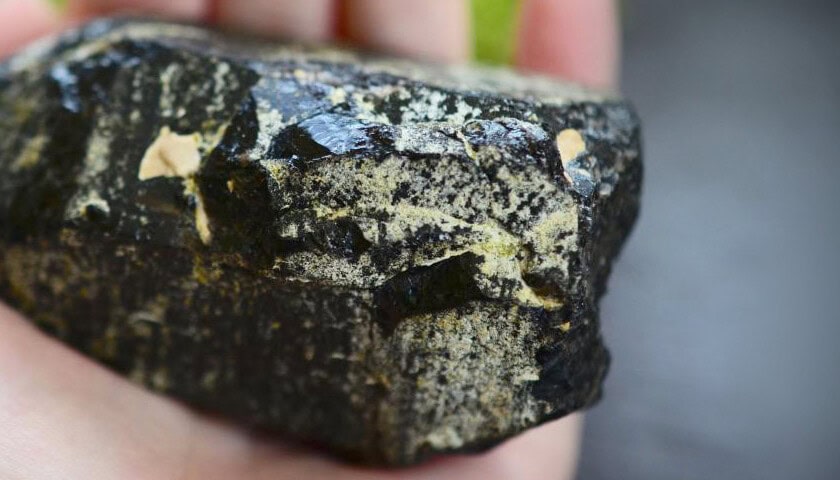
Quartz is a truly fascinating mineral, and it is particularly known for its incredible variety and versatility. One intriguing manifestation of this versatility is the existence of black quartz. With an alluring depth and a sense of mystery, black quartz varieties offer much to be admired. In this chapter, we’ll explore the captivating world of black quartz, focusing on four distinct varieties: Black Tourmalinated Quartz, Black Rutilated Quartz, Black Phantom Quartz, and Black Amethyst.
1. Black Tourmalinated Quartz

Immerse yourself in the mesmerizing beauty of Black Tourmalinated Quartz, a stunning variety of quartz that artfully combines clear or smoky quartz with dramatic inclusions of black tourmaline. These black tourmaline inclusions can be sparse or densely packed, creating striking patterns and unique aesthetics within each crystal.
Black Tourmalinated Quartz captures a unique intersection of energies. The quartz brings amplification and balance, while the black tourmaline’s grounding influence provides protection and purification. This harmonious blend makes Black Tourmalinated Quartz a sought-after gemstone in both aesthetic and metaphysical circles.
2. Black Rutilated Quartz
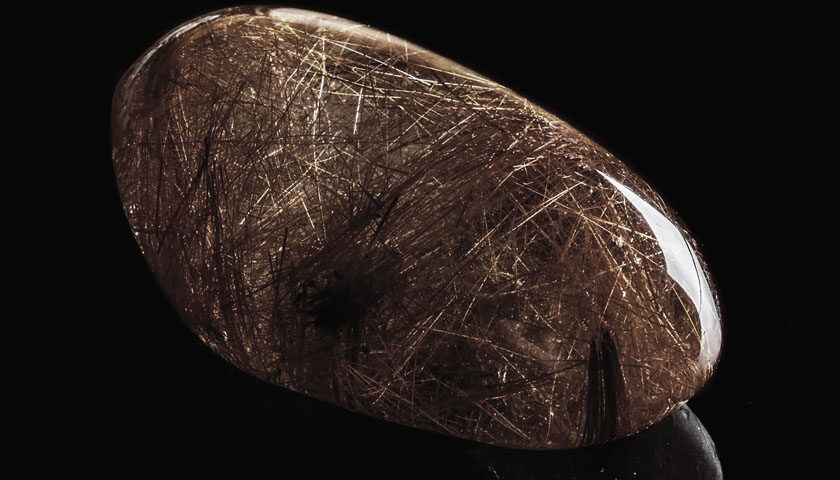
Venture now into the realm of Black Rutilated Quartz. Like its tourmalinated cousin, this quartz variety showcases dramatic inclusions, but in this case, they are needle-like rutile crystals. These inclusions form a stark contrast against the clarity of the quartz, creating a remarkable and captivating display.
The thin, thread-like rutile inclusions can vary in density and arrangement, ranging from scattered strands to dense, parallel arrays. The rutile threads in Black Rutilated Quartz often take on a deep black or dark grey hue, punctuating the stone’s clear or smoky body with their striking presence.
3. Black Phantom Quartz
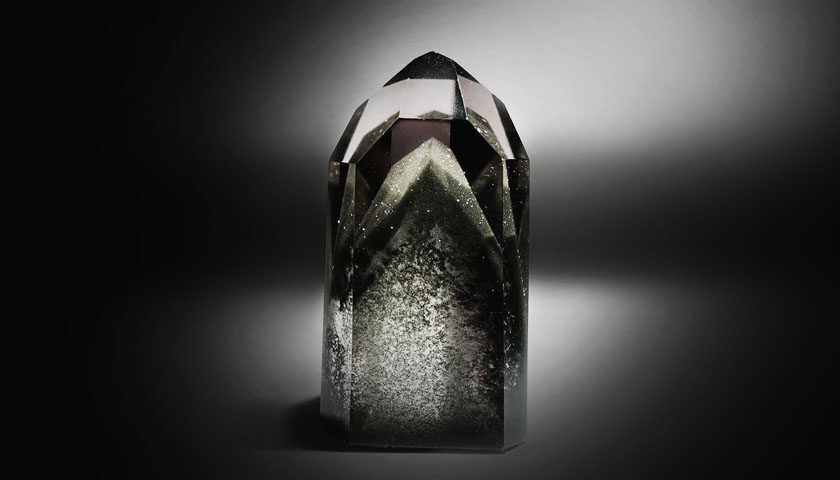
Next up is the alluring Black Phantom Quartz. This quartz variety stands as a testament to the stone’s geological history. Phantoms are ghost-like images of past growth stages of the crystal, captured within its body. In the case of Black Phantom Quartz, these “phantom” formations are distinctly darker, often due to inclusions of other minerals.
These phantoms create a layered, shadowy effect within the clear quartz crystal. Each phantom marks a stage in the crystal’s growth, effectively locking a piece of geological history within the stone. Black Phantom Quartz offers not just an aesthetic experience, but a journey through time, encapsulated within its darkened phantoms.
4. Black Amethyst
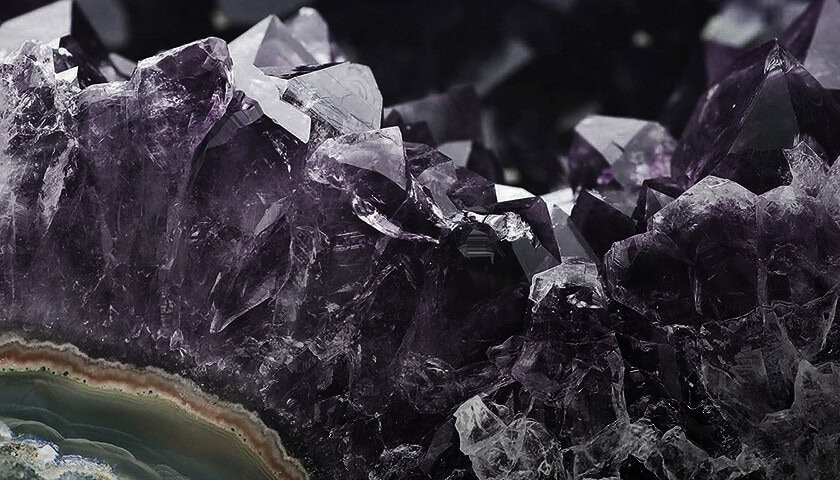
Finally, let’s delve into the enchanting world of Black Amethyst. This darker variant of the beloved purple quartz is truly a spectacle. Its intense hue, verging on black, is a result of high iron content and other trace elements, with each piece exhibiting its unique depth of color.
Black Amethyst, rich and intense, is especially captivating when held to the light, as it can reveal deep, smoky purple undertones. It is also said to carry the traditional amethyst properties of balance, peace, and protection, along with a more profound connection to intuition and the divine. A rare and prized gemstone, Black Amethyst is a striking addition to any collection.
5. Smoky Quartz
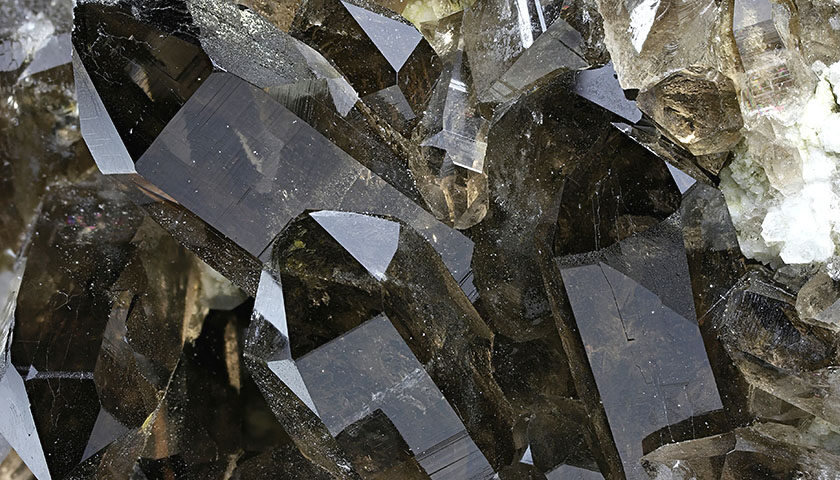
Let’s begin with the striking beauty of Smoky Quartz, a variety of quartz that captivates with its range of translucent hues, from a light smoky gray to a deep, almost opaque black. The smoky color is due to natural or artificial irradiation, which creates free silicon within the crystal, changing its color.
The unique property of Smoky Quartz is its depth and variation. Each stone presents a unique dance of light and shade, hinting at a myriad of browns, grays, and blacks. Smoky Quartz has been adored throughout history, with some cultures believing it to be a stone of power and grounding energy.
6. Onyx
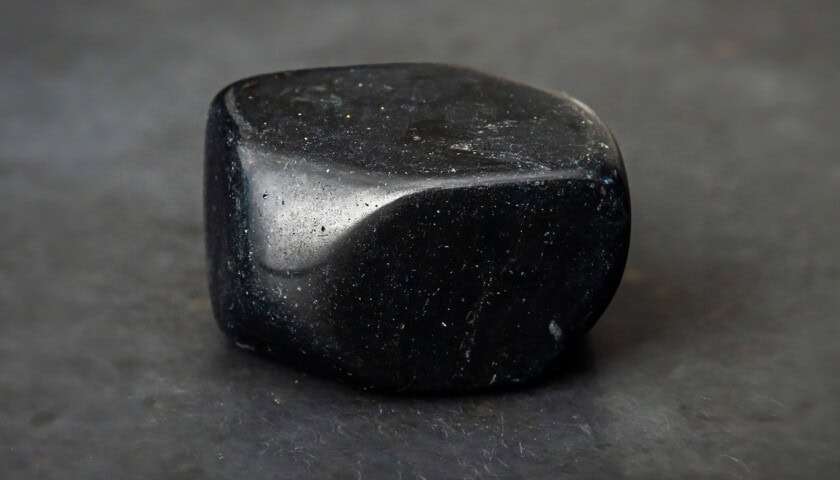
Step now into the enigmatic world of Onyx, a variety of chalcedony that carries a sense of profound depth and mystery. Onyx, particularly black onyx, offers a sleek, solid black, often achieved through dyeing. Its smooth, lustrous finish has made it a beloved choice for jewelry and ornamental pieces.
Onyx, with its rich black hue, projects an aura of strength and self-confidence. The stone’s intense coloration and smooth finish reflect an intriguing interplay of light, shadow, and texture that draws the eye and captivates the imagination.
7. Black Agate

As we venture further, we come across Black Agate. Like Onyx, Black Agate is a type of black chalcedony, microcrystalline quartz known for its opaque and often banded appearance. Black Agate is typically dyed to achieve a solid black color. Its gleaming surface reflects light beautifully, adding an extra layer of depth to the stone’s aesthetic.
Black Agate carries a sense of calm and stability, resonating with a grounding energy often associated with darker stones. It has been celebrated for centuries, with people around the world adoring it for both its physical beauty and its perceived metaphysical properties.
8. Black Jasper

Finally, we explore the rugged charm of Black Jasper. Known also as basanite, Black Jasper is a form of chalcedony that has an opaque and often earthy appearance. Its dark tone, which can range from deep green to almost black, conveys a strong connection to nature and the earth.
Black Jasper, with its grounding energy and protective properties, is believed by many to promote courage and determination. Its texture and hue vary, providing a unique aesthetic that beautifully captures the rugged, organic appeal of these fascinating stones.
Black Quartz Meaning and Symbolism
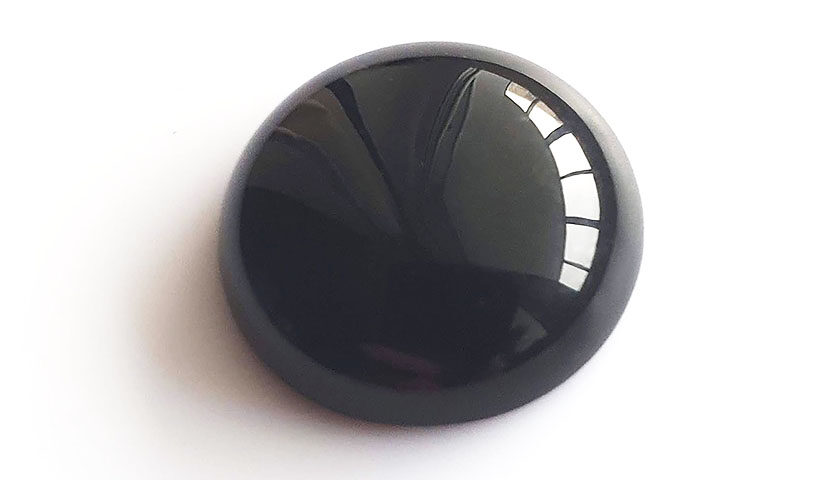
Quartz, in its myriad forms, has been revered throughout history for its beauty and perceived metaphysical properties. Black Quartz, cloaked in its dark, captivating hues, is no exception. It’s a stone associated with strength, protection, and grounding, imbued with deep symbolism and rich meaning.
Black Quartz’s dark hue is often linked to mystery, strength, and the unknown. It symbolizes protection and power, much like the night, providing a shield against negative energies. Many cultures view it as a protective stone, a spiritual ‘bodyguard’ warding off harmful influences and psychic attacks.
This enchanting mineral is also considered a powerful grounding stone, symbolizing our connection to the earth. Just as black, fertile soil nurtures the seeds, enabling them to grow, Black Quartz helps anchor your energy and fosters growth on a personal level. It encourages introspection and self-awareness, aiding in the exploration of the ‘shadow self’—the aspects of our personality that we keep hidden or choose to neglect.
Black Quartz Healing Properties

Harnessing the Strength within the Shadows: Emotional Benefits of Black Quartz
Feelings are a complex landscape, and at times, we could all use a bit of a guide. That’s where Black Quartz comes into play, our steadfast companion amidst emotional storms. Its dark and alluring depths seem to echo with a strength that’s both comforting and empowering.
Black Quartz is like a cosmic bodyguard for your emotions. It’s said to absorb negative energy, transforming it into positive vibes that can revitalize your emotional wellbeing. If you’re feeling stressed or overwhelmed, this captivating stone acts as an emotional shield, soaking up the anxieties and fears, leaving you feeling lighter and more optimistic.
From Darkness to Enlightenment: Spiritual Benefits of Black Quartz
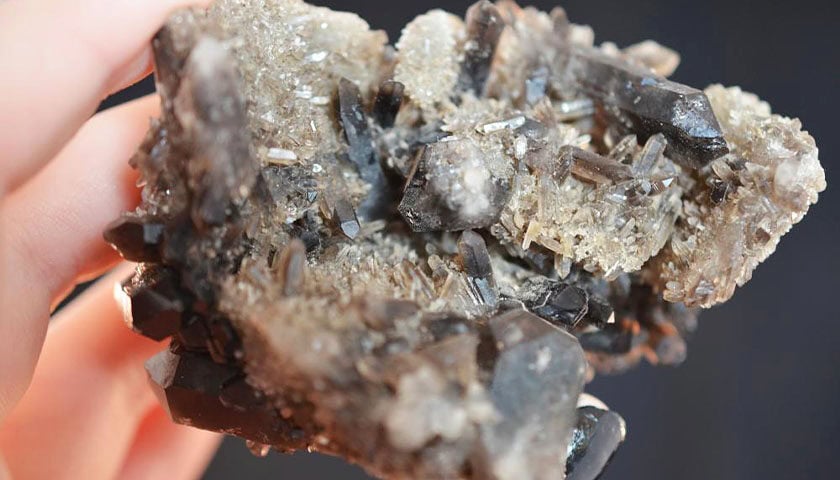
If emotional wellbeing is one side of the coin, spiritual growth is undoubtedly the other. And in this realm, too, Black Quartz shines—quite literally. This stone is regarded as a spiritual anchor, grounding your energy and connecting you with the deeper, more profound layers of your being.
Black Quartz is seen as a guide in the exploration of the self, helping you to delve into your ‘shadow side.’ These are the hidden parts of your personality, the fears, and insecurities you might prefer to ignore. Yet, with the aid of Black Quartz, you can explore these shadows with courage and understanding, illuminating your path towards personal growth and self-acceptance.
Black Quartz Metaphysical Properties

A Dance with Energy: Black Quartz and Chakras
If you’ve ever wondered what it’d be like to hold a piece of a starry night in your hands, look no further than Black Quartz. Its depth, its dark allure, speaks of cosmos and mysteries, pulling you into its dance of energy and vibrancy.
Black Quartz, with its grounding essence, is often associated with the root or base chakra, known in Sanskrit as ‘Muladhara’. Picture a swirling disk of red energy at the base of your spine, anchoring you to the earth. That’s your root chakra, the foundation of your energy system. When balanced, it instills a sense of stability, security, and inner strength.
Enter Black Quartz—your partner in this balancing act. Its energy is like a rhythmic drumbeat, resonating with the root chakra’s frequency. It helps ground and stabilize this chakra, bringing harmony and cultivating a deep sense of connection to the physical world. It’s like a bridge between you and Mother Earth, fostering a powerful grounding effect.
In addition, Black Quartz can also influence the third eye chakra, your spiritual command center, offering clarity of thought and vision, and encouraging intuition. Imagine an indigo lotus between your brows, opening its petals to wisdom and insight. Black Quartz is a key to this gate, aiding in the exploration of the inner self and the universe beyond the physical eyes.
Written in the Stars: Black Quartz Zodiac Connection
From the dance of energy within us, we journey to the cosmic dance above—the zodiac. Every gemstone has a zodiac connection, a sign it resonates with, and for Black Quartz, it’s the powerful and ambitious Capricorn.
Capricorn, the disciplined and responsible mountain goat, is known for its practicality and grounded approach. They’re the achievers, the hard workers of the zodiac. Just as Black Quartz is resilient and transformational, Capricorns too thrive on ambition and perseverance.
Black Quartz is like a mirror for Capricorn’s soul—a talisman that enhances their natural endurance and ambition while grounding their energy and encouraging emotional balance. Imagine a stone as steadfast as a Capricorn’s resolve, as resilient as their spirit, and as grounding as their earth sign—That’s Black Quartz for you.
How to Use Black Quartz

Inner Peace and the Cosmos: Meditating with Black Quartz
Ever tried navigating the cosmos within? Sounds like a sci-fi adventure, right? Well, that’s meditation for you. And adding Black Quartz to the mix? That’s like adding a bit of starlight to your journey.
Meditating with Black Quartz is like holding a compass that guides you through your inner universe. Its deep, grounding energy helps you remain centered, acting as an anchor in the vast ocean of your consciousness.
Try this: Start your meditation session holding a piece of Black Quartz in your hand, or place it nearby. As you sink into the tranquil depths of meditation, allow its energy to envelop you, forming a protective shield around your being. It’s like standing beneath a starry sky, feeling protected and grounded, yet limitless.
The presence of Black Quartz during meditation can enhance clarity and intuition, making your inward journey not just a path of self-discovery, but also an exploration of cosmic consciousness.
Harmonizing Energy Flow: Black Quartz in Feng Shui
Now let’s bring the cosmos a bit closer to home—right into your living spaces, with a bit of Feng Shui magic. Black Quartz, with its protective and grounding properties, is a great addition to your Feng Shui toolkit.
Black Quartz can be used to absorb negative energy and promote a harmonious flow of Chi, the life-force energy. Placing it in areas of your home where you feel the energy is stagnant or chaotic can bring about a calming, balancing effect. It’s like bringing a breath of fresh, cosmic air into your home.
Also, considering the Bagua, or the Feng Shui energy map of your home, placing Black Quartz in the North (Career and Path in Life area) can help strengthen your journey, acting as a beacon of resilience and transformation.
A Cosmic Companion for Everyday: Black Quartz at Home and Work
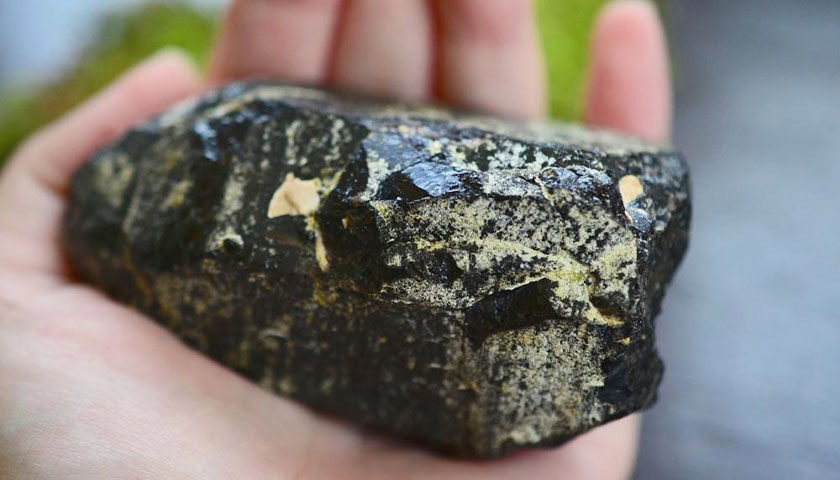
Why should the cosmos be limited to meditation and Feng Shui? Bring the stars to your everyday life by incorporating Black Quartz into your home and workspace.
Having a piece of Black Quartz at your workspace can act like a little cosmic bodyguard, warding off negative energy and promoting focus and clarity. It’s like having a piece of a starry night at your desk, anchoring you amidst the day’s chaos.
At home, place Black Quartz in areas where you’d like to foster a sense of grounding and protection. It could be your living room, creating a calming ambience, or your bedroom, promoting restful sleep. Just imagine, it’s like bringing a piece of the cosmos right into your home, transforming it into a sanctuary of peace and balance.
Wearing Black Quartz Jewelry
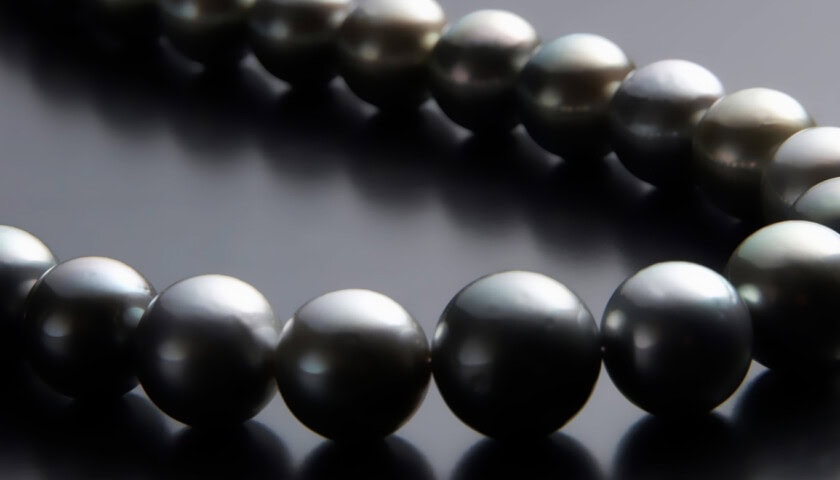
Black Quartz Necklaces
Black Quartz necklaces are more than just accessories—they’re your personal piece of the cosmos. Imagine the captivating sparkle of a star-strewn night sky captured within a gemstone and draped around your neck. It’s as mystical as it sounds. Not only does it add a touch of elegance to your ensemble, but it also brings the grounding and protective energies of Black Quartz closer to your heart—quite literally.
Black Quartz Rings
If you’re seeking a constant companion to navigate through the ebb and flow of life, consider wearing a Black Quartz ring. It’s like having a tiny universe on your finger, with the energy of the stars ready to ground and protect you. The beauty of Black Quartz rings lies not only in their aesthetic appeal but also in their symbolic representation of resilience and transformation.
Black Quartz Bracelets
Bracelets have been an integral part of adornment since ancient times, and when you add the power of Black Quartz to them, they transform into a piece of cosmic armor. Wearing a Black Quartz bracelet is like encircling your wrist with a constellation of energy, offering protection, grounding, and stability. And let’s not forget the style statement it makes—it’s a conversation starter, for sure!
Black Quartz Pendants
Imagine a droplet of cosmic night hanging from a delicate chain, swaying with your every move. That’s the charm of a Black Quartz pendant. Each time you wear it, it’s like you’re cloaking yourself with a protective veil of energy. Whether you wear it over a chic black dress or a simple white tee, a Black Quartz pendant not only elevates your style but also your vibes!
Black Quartz Earrings
Earrings are not just about accessorizing—they’re about making a statement. And when it’s Black Quartz earrings we’re talking about, you’re making a stellar statement. It’s like having your ears dusted with a sprinkle of the cosmos, echoing the enchanting allure of a starry night. Beyond their beauty, they bring the protective and grounding energies of Black Quartz closer to your head, influencing your thoughts and intuition.
Black Quartz Beads
Beads, whether in a necklace, a bracelet, or even a simple string, have an appeal that’s both timeless and universal. Now, imagine those beads formed from Black Quartz—like tiny orbs of stardust strung together, radiating a dark, captivating sparkle. They’re a great way to carry the energy of Black Quartz with you, in a form that’s flexible and versatile. Plus, they make a cool style statement too!
Sculpted By The Cosmos: Black Quartz Shapes and Forms
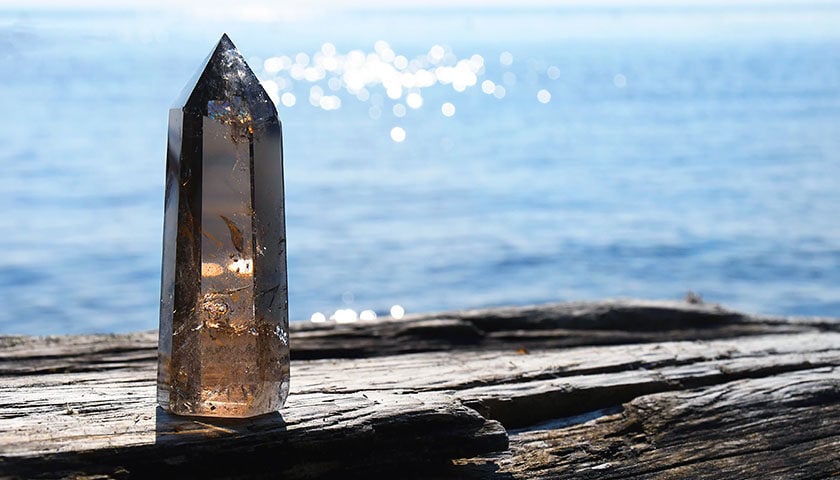
Black Quartz Tumbled Stones
Tumbled stones are like nature’s way of creating smooth pebbles. Through a process that mirrors the natural tumbling of a river, Black Quartz transforms into these delightful rounded stones. With their soft, inviting touch, Black Quartz tumbled stones are perfect for carrying in your pocket or for use in crafts and jewelry.
Black Quartz Polished Stones
Polished stones represent the raw beauty of Black Quartz enhanced by human intervention. Each stone is carefully shaped and polished to bring out the captivating sparkle and depth of Black Quartz. Ideal for display, these polished beauties can transform any space into a galaxy of grounding energy.
Black Quartz Rough Stones
Rough stones are Black Quartz in its rawest, most unadulterated form. Like chunks of night sky fallen to Earth, they’re an unfiltered expression of cosmic energy. Use these to connect with the untamed, raw energies of the universe, or simply as a unique decorative piece.
Black Quartz Spheres
There’s something hypnotic about the perfect symmetry of a sphere, and when it’s a Black Quartz sphere, it’s like holding a galaxy in your hands. They’re not just mesmerizing to look at, but also ideal for energy work and meditation, radiating their protective energy in all directions.
Black Quartz Hearts
Carved into heart shapes, Black Quartz transforms into a symbol of cosmic love. These hearts are not just about emotional love, but also about self-love and universal love. They’re a reminder that, like Black Quartz, love is a force that’s transformative, grounding, and protective.
Black Quartz Pyramids
Pyramids are symbols of ascension, and a Black Quartz pyramid is like a beacon of grounding and protective energies. Each pyramid is a journey in itself, guiding your energies from the base to the apex, helping you navigate life’s ups and downs.
Black Quartz Wands
Wands have been symbols of power and intent for centuries. When shaped from Black Quartz, they transform into conduits of cosmic energy. Use these for focused healing work, or as a personal talisman that amplifies your intent.
Black Quartz Palm Stones
Palm stones are shaped to fit comfortably in your hand, making them ideal for meditation or stress relief. A Black Quartz palm stone is like a soothing cosmic balm, its cool touch and grounding energy providing comfort whenever you need it.
Cabochons
Last but not least, Black Quartz cabochons are polished gems, often used in jewelry. They carry the same energetic properties as Black Quartz, but in a form that’s designed to catch the eye. Each cabochon is like a tiny universe of its own, ready to be worn and appreciated.
Black Quartz vs Black Tourmaline
Diving into the world of gemstones, let’s first compare Black Quartz and Black Tourmaline. These stones are both known for their dark, enigmatic beauty, but they differ significantly in their composition and characteristics.
Black Quartz, primarily formed of silica, exhibits a wide range of transparency levels. Its hues vary from opaque black to smoky gray, creating fascinating layers of depth. On the other hand, Black Tourmaline, or schorl, contains a complex recipe of elements, including aluminum, iron, and boron, among others. This composition lends it an opaque, glassy black appearance.
When it comes to origin, both stones are widely distributed. Quartz is found globally, whereas Black Tourmaline has notable deposits in Brazil, Africa, and the United States. But the real difference shines in their uses and value. Black Quartz, especially in jewelry, is sought for its mysterious allure and metaphysical properties, with price tags typically ranging from $10 to $200 per piece depending on size, quality, and treatment. Black Tourmaline, while also revered for protective qualities, has a broader range of uses, including in scientific equipment due to its ability to generate an electric charge under pressure. You’ll find its pricing similar to Black Quartz, hovering between $10 and $300 for a quality specimen.
Black Quartz vs Black Calcite
Our next comparison is Black Quartz versus Black Calcite. While they share a color, these two gemstones diverge in their structures and visual features.
Calcite, formed from calcium carbonate, often shows a waxy or pearly luster, and its black variety can range from deep charcoal to an almost metallic black. Black Quartz, in contrast, leans towards a vitreous luster and displays an array of blacks and grays.
Calcite is typically found in sedimentary rock environments, particularly in regions with high limestone content like Mexico. Black Quartz’s distribution is far more global. In terms of usage, Black Calcite, with prices generally between $5 and $150, is highly regarded in the metaphysical realm for its grounding properties. Black Quartz, as discussed earlier, also holds metaphysical significance and its prices can stretch from $10 to $200 depending on various factors.
Black Quartz vs Black Fluorite
Black Fluorite, a mineral formed from calcium fluoride, is our next contender. Although Fluorite comes in many colors, the black variety is not common and is cherished by collectors. Black Quartz, though more common, holds a charm that isn’t lost on crystal lovers.
Fluorite exhibits perfect cleavage, meaning it breaks along smooth, flat planes. Its luster can range from glassy to dull, while Black Quartz commonly has a vitreous luster. Fluorite deposits are plentiful in countries like China and Mexico, while Quartz is found worldwide.
Black Fluorite’s pricing varies wildly based on quality and rarity, but you might find pieces between $20 and $400. It’s praised for its potential to enhance intuition and clarity. On the other hand, the versatile Black Quartz, priced similarly, is believed to aid in emotional healing and grounding.
Black Quartz vs Black Jade
Finally, let’s explore the comparison between Black Quartz and Black Jade. Jade, a name shared by two different minerals (Jadeite and Nephrite), is highly prized, especially in Asian cultures, for its toughness and potential spiritual properties.
Black Jade, whether Jadeite or Nephrite, typically exhibits an even, deep black color and a greasy to vitreous luster. It’s worth noting that true Black Jade is relatively rare and often hails from regions like Wyoming or Australia. On the other hand, Black Quartz’s various black to gray hues and widespread availability make it a more accessible choice.
When it comes to pricing, genuine Black Jade can command prices anywhere between $30 and a few thousand dollars due to its desirability and rarity. Black Quartz’s pricing remains more modest, typically spanning $10 to $200. Both stones are known for their protective qualities, but Black Jade, especially in Asian cultures, is often seen as a symbol of power and immortality.
Black Quartz vs Black Agate
Our gemstone journey continues as we compare Black Quartz with Black Agate. Although both are silica-based, they significantly diverge in their formation process and characteristics.
Black Agate, a variety of chalcedony, forms from microscopic quartz crystals laid down in bands. This often results in beautiful banded patterns, creating layers of depth and mystery. Conversely, Black Quartz’s hue comes from various mineral inclusions or radiation exposure.
When it comes to origin, Black Agate is commonly found in volcanic rocks or ancient lavas where it fills the veins or cracks. Black Quartz, in contrast, has a more universal distribution. As for their uses and value, Black Agate, typically priced between $5 and $50, is popular in jewelry and is highly regarded for its stabilizing and strengthening influence. On the other hand, Black Quartz, with prices ranging from $10 to $200, is believed to offer grounding and purifying properties.
Black Quartz vs Obsidian
Next up is a comparison of Black Quartz and Obsidian. Despite their color similarity, these two are formed through entirely different processes.
Obsidian, also known as volcanic glass, is an igneous rock that forms when lava cools rapidly, not allowing time for crystal growth. It’s usually jet black with a glassy luster, making it appear sleek and reflective. In contrast, Black Quartz is a crystalline mineral formed from cooling magma or silica-rich water, exhibiting varying levels of transparency and a vitreous luster.
While Black Quartz is found worldwide, Obsidian’s occurrence is restricted to areas of past or present volcanic activity. It’s used predominantly for ornamental and jewelry purposes and occasionally for surgical scalpel blades due to its sharpness when fractured. Depending on the size and quality, Obsidian pieces can range from $5 to $100. Black Quartz’s prices can stretch from $10 to $200 depending on various factors, and it’s esteemed for its reputed protective and healing qualities.
Black Quartz vs Black Kyanite
When it comes to Black Quartz and Black Kyanite, these stones offer unique features and vibes despite their similar hues. Black Kyanite, an aluminum silicate mineral, often forms in blade-like crystal clusters, giving it a distinctive appearance.
In contrast to the varying transparency of Black Quartz, Black Kyanite is typically opaque, displaying a near metallic luster. While Quartz has a global distribution, Black Kyanite is primarily found in Brazil, USA, Switzerland, and Austria.
In terms of uses and value, Black Kyanite, with prices generally between $5 and $75, is respected among crystal healers for its grounding properties and is used as a balancing stone. Black Quartz, however, is believed to purify and protect the spiritual self.
Black Quartz vs Hematite
Lastly, let’s delve into Black Quartz versus Hematite. Hematite, an iron oxide mineral, is known for its metallic to dull luster and high density, which gives it a pleasing, weighty feel when held.
Hematite’s colors range from steel gray to almost black, while Black Quartz plays with an array of blacks and grays. Hematite is typically found in sedimentary, metamorphic, and igneous rocks and is widespread globally, similar to Black Quartz.
In terms of use and value, Hematite has been used throughout history for its red pigment, and today, it’s popular in jewelry and as a healing stone, with prices ranging from $5 to $75. It’s believed to aid in grounding and balancing energies. Meanwhile, Black Quartz is often used for its supposed protective and purifying properties, and its prices range between $10 to $200.
Frequently Asked Questions About Black Quartz
What gives Black Quartz its color?
Black Quartz gets its color from mineral inclusions like tourmaline, hematite, and goethite.
Is Black Quartz the same as Smoky Quartz?
No, although both are Quartz varieties, they differ in color. Smoky Quartz has a brown or smoky grey color, while Black Quartz is distinctly darker.
How do I clean my Black Quartz?
Black Quartz can be cleaned gently with warm soapy water and a soft brush. Avoid harsh chemicals and ultrasonic cleaners.
Can Black Quartz fade in the sunlight?
Yes, prolonged exposure to sunlight can cause Black Quartz to fade, so it’s best to store it away from direct sunlight.
Can I wear Black Quartz daily?
Yes, Black Quartz is a hard and durable gemstone that can withstand daily wear.
What chakras is Black Quartz associated with?
Black Quartz is often associated with the Root chakra.
What’s the difference between Black Quartz and Black Tourmaline?
While both are grounding and protective stones, they differ in composition. Black Quartz is a silicate, while Black Tourmaline is a borosilicate mineral.
Can I put Black Quartz in water?
Yes, Black Quartz can be submerged in water. It’s often used in elixirs.
Is Black Quartz a sun safe crystal?
Black Quartz can fade with prolonged exposure to the sun, so it’s not considered a sun safe crystal.
| Black Quartz Physical Properties | |
|---|---|
| Crystal Structure | Hexagonal |
| Mineral Class | Silicate |
| Specific Gravity | 2.65 |
| Formula | SiO2 |
| Hardness | 7 on Mohs scale |
| Transparency | Transparent to nearly opaque |
| Chemical Composition | Silicon dioxide |
| Locations | Worldwide (notably Brazil, Madagascar, USA) |
| Rarity | Common |
| Can Be Submerged in Water | Yes |
| Sun Safe Crystal | No, prolonged sun exposure may cause color fading |
| Special Care Instructions | Clean gently with warm soapy water and a soft brush, avoid harsh chemicals |
| Price/Carat | $10 – $100 (depending on the size, quality, and presence of inclusions) |
| Black Quartz Metaphysical Properties | |
|---|---|
| Chakras | Root Chakra |
| Zodiac Signs | Capricorn, Scorpio |
| Planets | Saturn |
| Numerical Vibration | 3 |
| Elements | Earth |
| Symbolism | Grounding, Protection, Transformation |
| Birthstones | Not traditionally associated as a birthstone |
| Affirmations | “I am grounded and protected.” |
| Emotional Conditions | Anxiety, Fear, Negativity, Stress |
| Spiritual Purposes | Grounding, Protection, Psychic Protection, Absorbing Negative Energy |
| Crystal Combinations | Combines well with grounding stones like Hematite, Smoky Quartz, and Red Jasper for enhanced grounding and protection |



